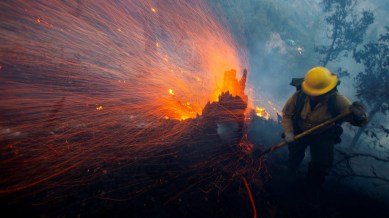Stay updated with the latest - Click here to follow us on Instagram
Los Angeles fires: What’s hampering firefighting efforts?
Infrastructural challenges facing firefighters can become lessons in facing future disasters.

The fires billowing across Los Angeles in California have led to widespread destruction, killing at least seven people and destroying acres of land and property. About 1,80,000 people have already been evacuated.
Visuals from the coastal city show burning houses and vehicles. Iconic landmarks, charred black, are set against an eerie orange glow in the skies.
monthly limit of free stories.
with an Express account.
Two of the worst fires, and among the largest in Los Angeles history, remain uncontained. The Palisades fire, which experts have called the “largest fire in the history of Los Angeles”, has spread across nearly 20,000 acres and destroyed more than 5,000 structures, including the affluent residential neighbourhood of Pacific Palisades. The Eaton Fire, spread across 13,700 acres, too has destroyed over 5,000 structures. A new fast-moving Kenneth Fire, which was spotted on Thursday, has added to the woes of the beleaguered firefighters.
Whipping dry winds, moving at 100mph, are helping the fires spread at a meteoric pace. They are also preventing helicopters and scooper planes from dropping water and fire retardants onto the flames. While the winds eased to a certain extent on Wednesday night, they are expected to again pick up pace on Friday and the weekend.
While dry climatic conditions and the powerful Santa Ana winds are responsible for the rare winter fires, infrastructural challenges may have worsened the problem. Take a look:
Water shortage
Fire hydrants quickly ran dry as out-of-control fires swept across the Palisades neighbourhood. Officials quoted by The New York Times (NYT) said that the storage tanks could not keep up with the firefighting demands. The pump-and-storage systems that feed the hydrants have been designed to fight urban fires rather than wildfires that spread fast and wide.
A Los Angeles City Council member told the NYT that the water systems were “critically underfunded”, and did not expand with the city’s growth.
Rescuers are now turning to airdropping water and fire retardants, which was impossible during the initial days of the firefighting efforts.
Personnel shortage
On Wednesday, the LA County Fire Chief Anthony Marrone told reporters, “We don’t have enough fire personnel in LA County between all the departments to handle this.” As many as 9,000 firefighters are employed by the fire department and 29 other fire agencies, which Marrone, said was “not enough” to fight the current crisis. The LA Fire Department has issued a notice to recall all off-duty crew to assist in the rescue operations.
The staffing crisis has put a spotlight on the recent budget cut for the fire department. This fiscal year, the fire department’s budget was $23 million less than the previous year. According to an NYT report, the budget cut reduced money available to pay overtime for firefighters as it eliminated 73 vacant civilian positions. A firefighters union leader, Freddy Escobar, told the NYT that the budget cuts have also meant fewer mechanics to maintain the fire department’s vehicles, and less chance of hiring more crew in times of crisis.
The federal government and other states have sent in resources and firefighting crews to assist local efforts.
Poor evacuation plan
For years, residents of Pacific Palisades — the worst hit — have insisted on an evacuation plan for situations just like the current one. The rugged topography of the area, with winding and steep roads, makes evacuation in case of emergencies a tough task.
The number of people trying to flee in the face of the wildfires led to massive traffic jams in the area. Many residents were forced to leave their cars behind and continue on foot. The scores of abandoned vehicles became a challenge for first responders as they were unable to reach the intended sites. Videos from Palisades showed bulldozers clearing up the path for firefighters.
Exposed power lines
While the cause of the fires is yet to be determined, the city’s power lines have come under the scanner. High-speed winds can snap power lines, which can ignite dry vegetation. One of the largest fires in Californian history which destroyed Ventura and Santa Barbara counties in 2017, was sparked by power lines, news agency AP reported.
Experts cited by the NYT have urged authorities to bury the power lines to reduce the risk of such fires.
While the utility department has now cut power in affected areas, a Wall Street Journal report states that the Los Angeles Department of Water and Power was missing a key safety protocol that “shuts off part of its system during a windstorm to reduce the risk of sparks from its power lines”.